No one would have imagined that what began as a resentment for the monarchy would turn into a bloody global war. Fueled by the pride of nationalistic leaders, miscalculations, and broader alliances, World War I has never-ending lessons for the major powers today.
And, to grasp these lessons, understanding the chronology of events is crucial. This is where many feel puzzled as international and regional actors keep adding. But no more with this one-stop World War I timeline.
In this article
No one would have imagined that what began as a resentment for the monarchy would turn into a bloody global war. Fueled by the pride of nationalistic leaders, miscalculations, and broader alliances, World War I has never-ending lessons for the major powers today.
And, to grasp these lessons, understanding the chronology of events is crucial. This is where many feel puzzled as international and regional actors keep adding. But no more with this one-stop World War I timeline.
World War I Timeline Explained in Order
June 28, 1914 - The Sarajevo Incident
A Bosnian nationalist student assassinated Archduke Ferdinand and his wife, Sophie, on their way to inspect the armed resistance in occupied Sarajevo.
July 28, 1914 - The War Officially Begins
One month later, Austria-Hungary declared war on Serbia, blaming the rival government for the assassination of King Franz Joseph’s heir. Russia's call to France in response officially triggered World War I.
August 1 to 28, 1914 - Regional Alliance Against Germany
Germany’s declaration of war on Luxembourg, Belgium, Russia, and France in the early days of August led European nations to build an alliance against it. Here are a few significant events that escalated the regional war scenario.
- Western European forces, along with Japan, South Africa, and Montenegro, allied against Germany
- France invaded Alsace
- The British Expeditionary Forces launched an offensive against France.
- Battle of Frontiers between French and German forces.
- Battle of Tannesberg between Russia and Prussia, which ended with the Russian army taking 125000 war prisoners.
September 6, 1914 - Trench Warfare Begins with the First Battle of Marne
The First Battle of the Marne started when Germany advanced 30 miles into Paris, compelling France to reinforce its infantrymen. Consequently, the German forces dug along the north of the Aisne River, beginning the trench warfare on the Western Front.
November 5, 1914 - Ottoman Empire Enters the War
Britain and France declared war on the Ottoman Empire. An attack on the Russian fleet initiated the entry of the Turkish Empire into the war.
April 22, 1915 - Battle of Ypres
Germany used chemical weapons against the Allied troops hidden in trenches. In the Battle of Ypres, with each side using a considerable amount of chemical weapons, France and Algeria lost approximately 5000+ troops.
April 25, 1915 - Allies Landed on the Gallipoli Peninsula
On April 25, the Allied forces, particularly New Zealand and Australia, attempted to capture the Gallipoli Peninsula of the Ottoman Empire, yet remained unsuccessful. Eventually, it led to the collapse of the UK government.
May 7, 1915 - The British Ocean Liner Lusitania Sank
During the early months of 1915, Britain experienced consecutive defeats, including that of Lusitania. This ocean liner was torpedoed by a German U-boat, killing 1200 people, including 128 US citizens. The liner was also carrying heavy ammunition.
Feb 21, 1916 - Battle of Verdun Begins
The Battle of Verdun between Germany and France lasted for ten months. It resulted in 700,000+ casualties, wiping out the entire French village.
May 31, 1916 - The Naval Blockade of Jutland
The two big rivals of WWI, France and Britain, had a faceoff on the Jutland coast of Denmark. In retrospect, analysts declared this battle irrational and indecisive.
July 1, 1916 - Battle of Somme
The Allied powers attempted to reverse the German conquest of Verdun. Despite suffering heavy losses, including the 2000 troops, Britain declared this battle a success.
Fact: July 1, 1916, was the bloodiest day in the British Army’s history.
March 15, 1917 - Tsar Nicholas II of Russia Abdicated
The revolutionaries in St. Petersburg overthrew Tsar Nicholas II, marking the end of the Romanov Dynasty and the Russian Revolution. The official rule of Vladimir Lenin and the Bolsheviks started in March 1917.
April 6, 1917 - US Entry into the War
Ending his long policy of neutrality, Woodrow Wilson, the US president, officially entered the war against Germany. He was primarily upset with Germany using unrestricted submarines on the battlefront.
November 20, 1917 - British Forces Drive the Germans Away
World War I's first large-scale tank battle started with a British offensive in Cambrai against the German forces. The British Expeditionary Forces initially took approximately 7500 war prisoners, but retreated in two weeks due to harsh weather conditions.
March 3, 1918 - Treaty of Brest-Litovsk
On March 3, the Soviet government gave in to the Axis Powers following subsequent suffering due to a lack of manpower and delays. Resultantly, both parties agreed to peace in the Treaty of Brest-Litovsk.
November 11, 1918 - Armistice Day
Following the revolutionaries' causing internal disturbances, Germany realized that it was no longer capable of a long battle. Consequently, it gave in, and both sides agreed to the Armistice. Woodrow Wilson’s 14 points mainly inspired this peace arrangement.
How to Make a Similar Timeline using EdrawMax?
Complex historical episodes like World War I demand visualization of events, and a good way to do that is a timeline. These infographics illustrate the data in a way that is easily understandable by the mind.
Let’s see how you can replicate a diagram similar to the World War I timeline using EdrawMax, a comprehensive timeline software.
Step1Open a Blank Canvas
Before you begin, download EdrawMax or try its online version.
- Once you are logged in, explore the dashboard and visit the Home button.
- Click Basic Diagram > Timeline from the on-screen menu.
- Select a blank canvas from down below to enter the editing panel.
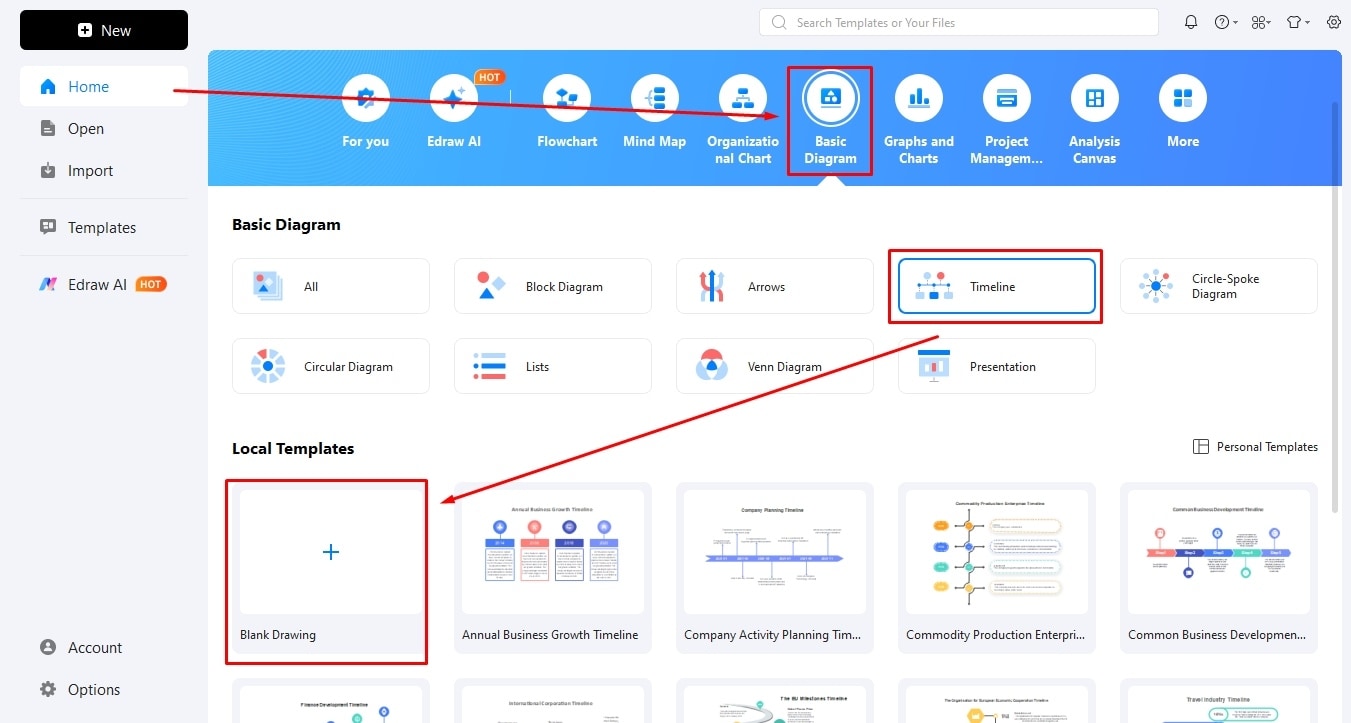
Step2Plot the Structure
Begin by plotting the structure. You can do this manually by arranging shapes. But a more efficient way would be to use EdrawMax's resizable vector symbols.
- Locate the Symbol library on the left side of the canvas.
- Take a moment to decide whether you want a horizontal or vertical structure and scroll down the Timeline section to find your desired layout.
- Drag and drop it onto the canvas.
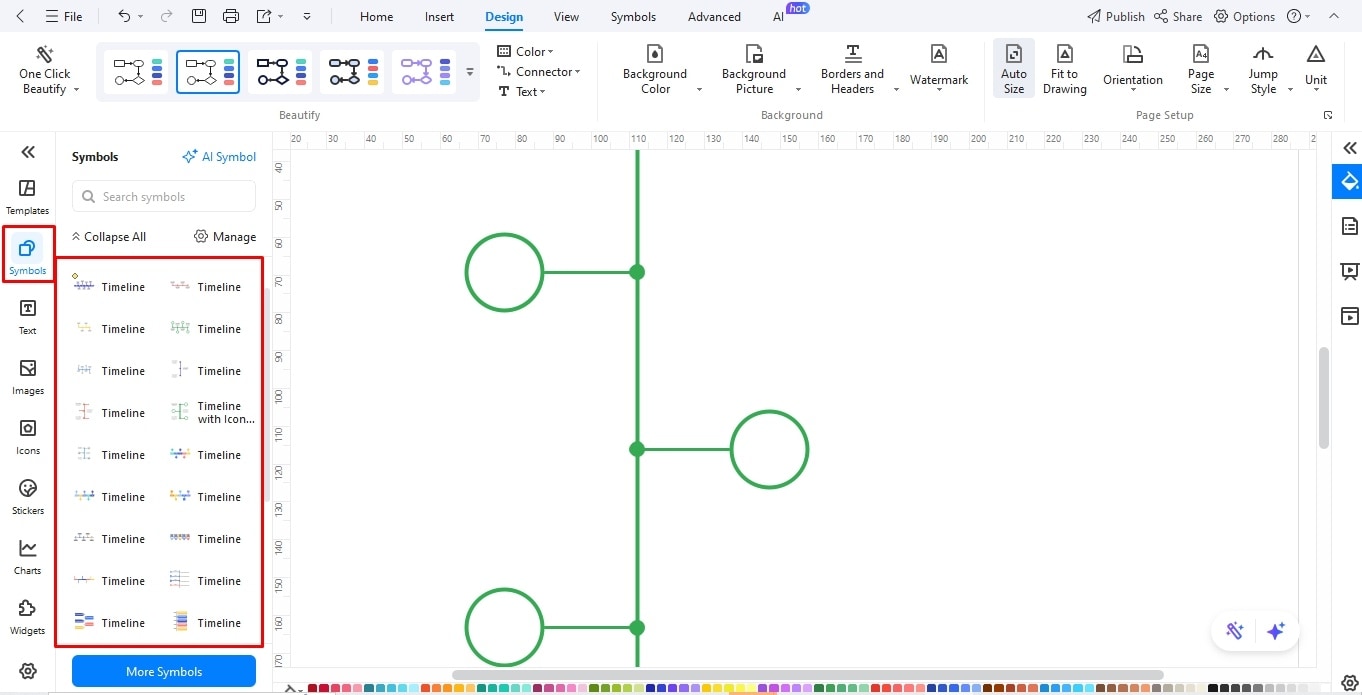
Step3Adjust the Milestones
Once done, let’s modify our timeline structure further. Select your layout and customize the following.
- Number of milestones: For the World War I timeline, let’s increase the milestone number to 16.
- Milestone size: Decide whether you want small, medium, or larger milestone indicators.
- Timeline type: Choose between a horizontal or vertical layout.
- Line design/direction: Change the color, style, flow, etc. of the lines representing the milestones.
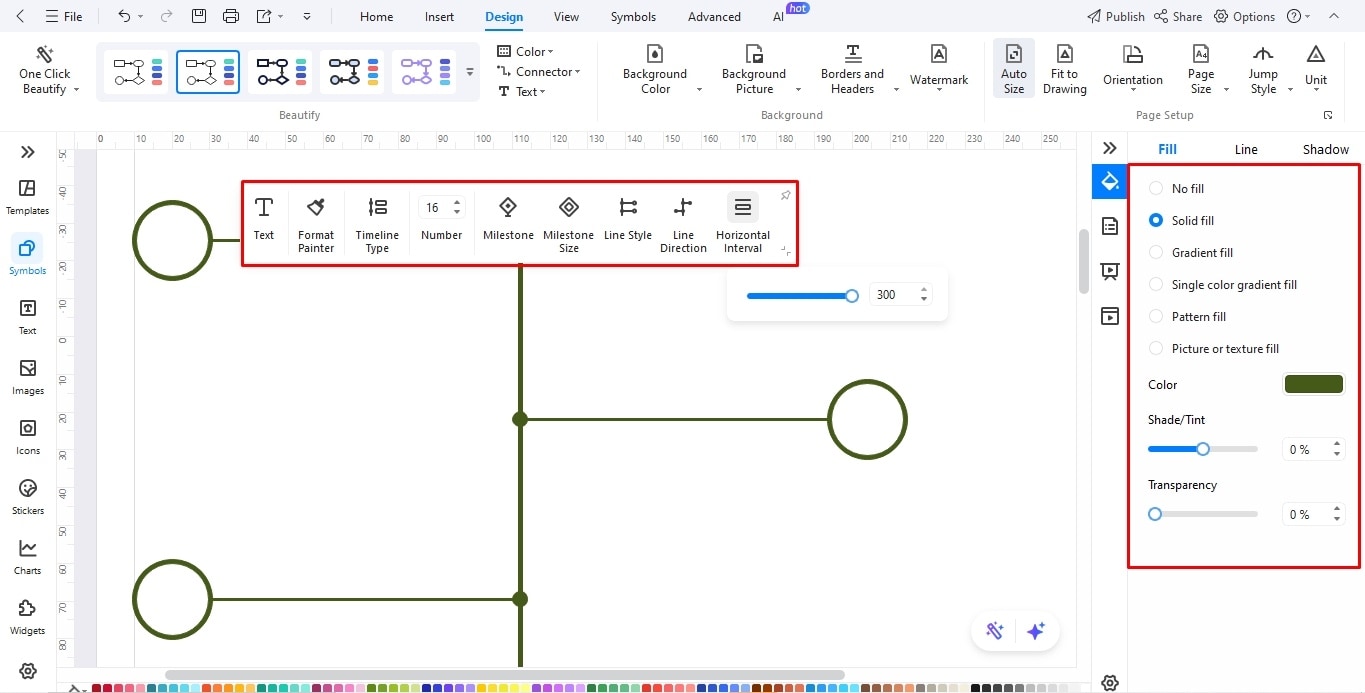
Step4Add Event Description
Are you sure about the structure? If yes, let’s proceed to one of the most important things: content.
- Double-click anywhere on the canvas and start typing. Add event titles and their descriptions.
- Change the font size, style, and color, as suits the layout, from the on-screen prompt.
- The timeline descriptions are tricky. Though a little longer, the text does not have to be wordy and excessive. Not sure how to begin? Use Edraw AI.
- Select your text and click Edraw AI from the on-screen menu.
- Shorten your event’s description, translate it, polish the text, or summarize it accordingly.
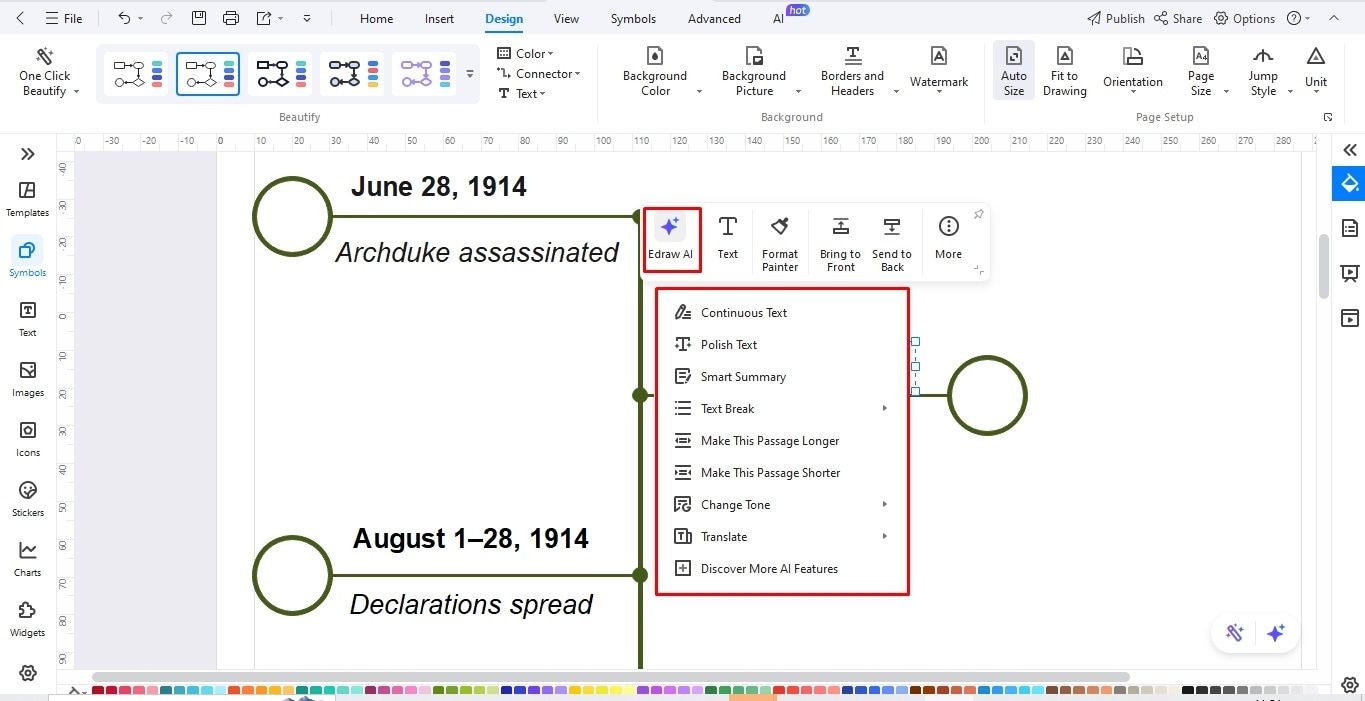
Step5Insert Visual Cues
Most people stop here! But we will not, as adding visual cues gives your audience a reference to visualize and remember the major milestones in history. For this,
- Copy any desired picture from an online source and paste it on the canvas.
- Alternatively, visit the Image libraries from the left side and search for your keyword. Scroll down to find a suitable picture.
- You can modify the picture frame, contrast, transparency, and more from the on-screen prompt.
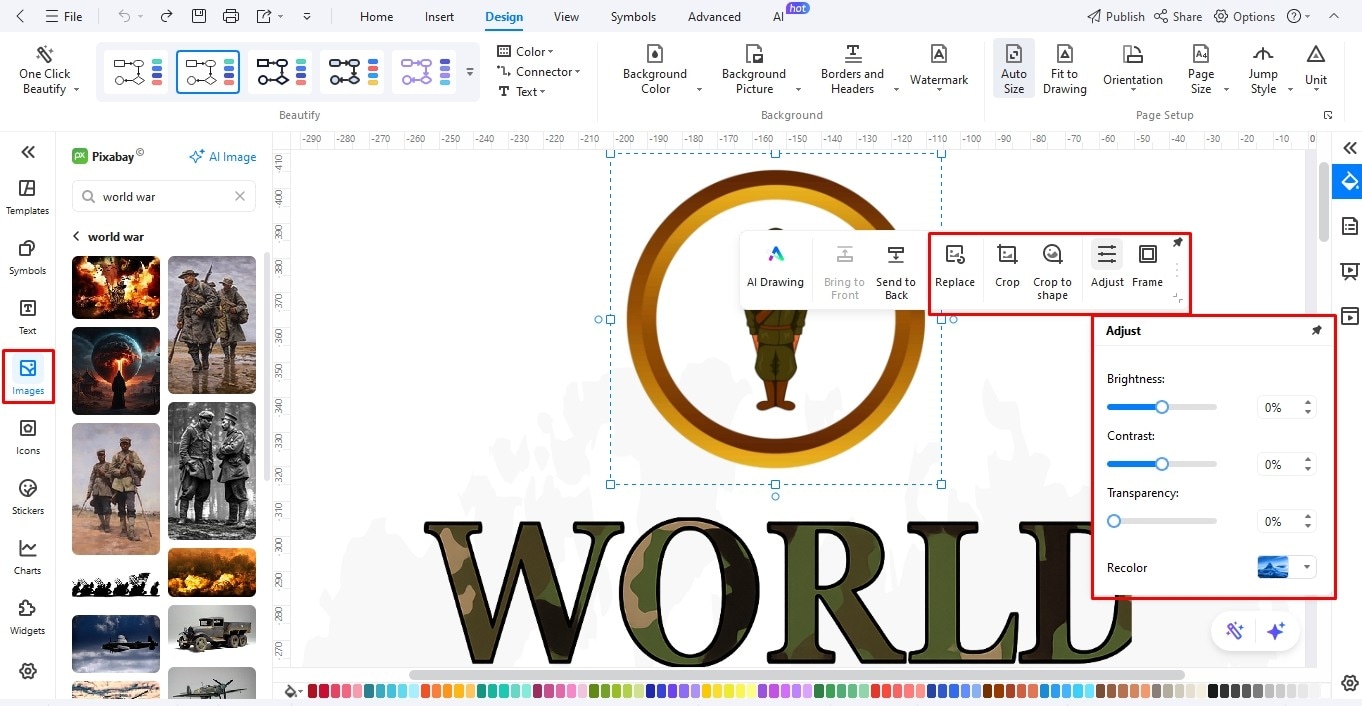
Step6Modify Design
We’re almost there. Let’s decide on the theme of your diagram. You can use the color-coding technique, such as a red color for descriptions and a grey color for events, etc. To do this,
- Change the colors of your diagram from the on-screen prompts on the canvas.
- Go to the Themes section under the Design tab and click Save Theme.
- You can also use existing themes to your liking.
- Alternatively, use a picture from the Image library to set as the background of your diagram.
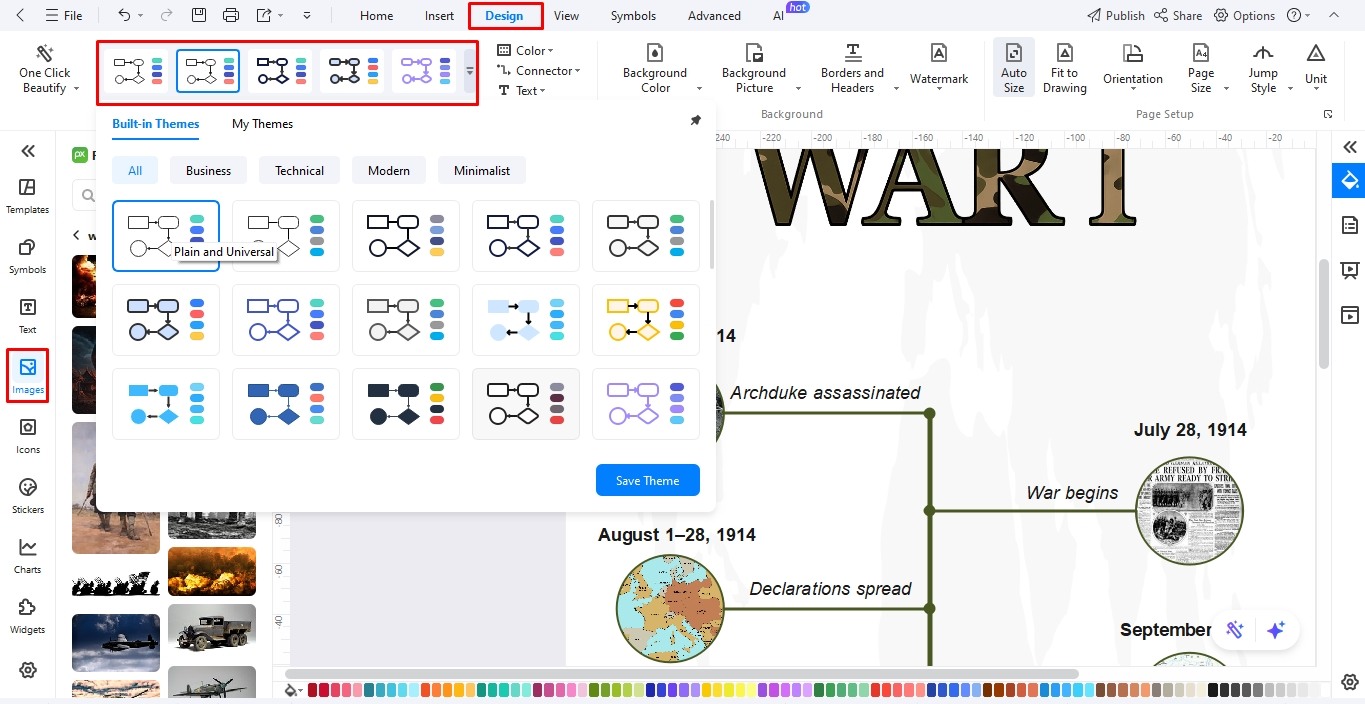
Step7Share with Others!
Ta-da, your World War I timeline is all ready to be shared. EdrawMax gives you the option to invite others for feedback.
- Locate the Share button on the top-right quick-access toolbar.
- Change permission to who can view, edit, and leave comments on your diagram.
- Or, distribute the system-generated diagram link to your preferred people.
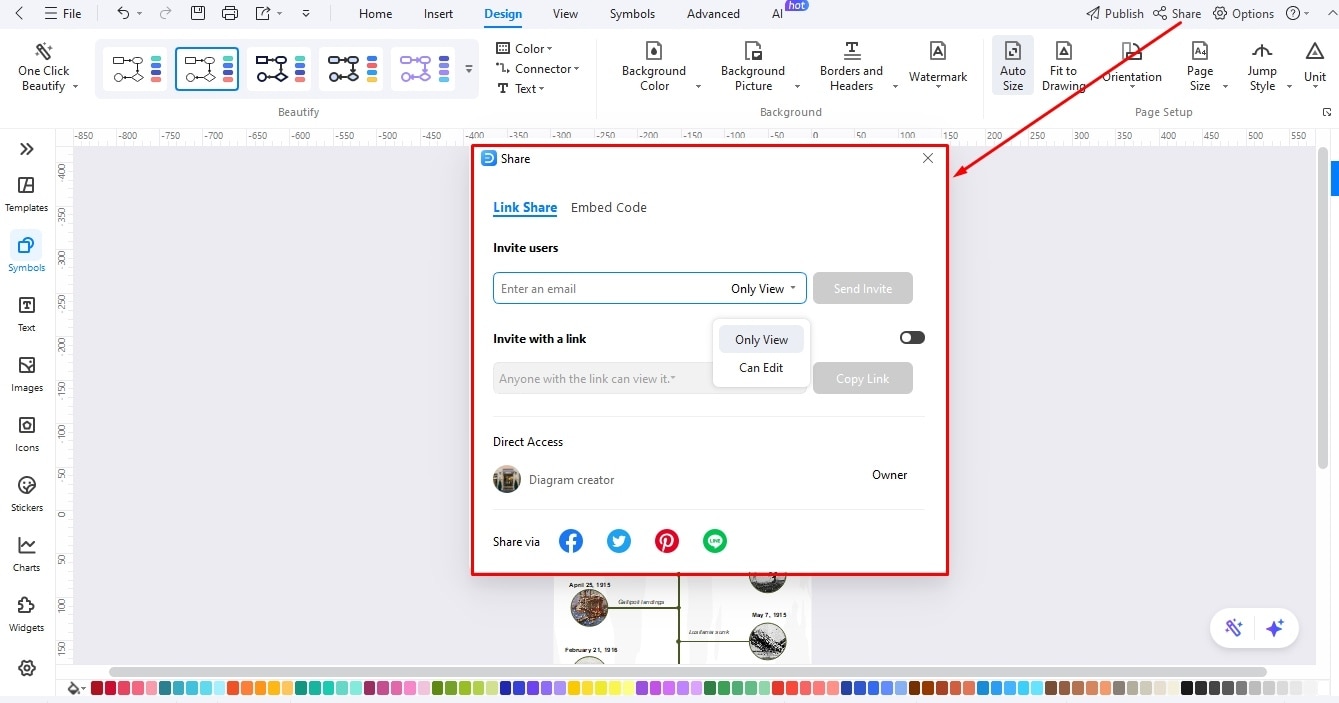
Wrapping Up
There you have it - the World War I timeline. It depicts how the nationalistic motivations of leaders and strategic mishaps resulted in the bloodiest war of modern politics. You can replicate similar infographics with minimal effort using EdrawMax. Its resourceful toolkit and resizable symbols help you kickstart your journey of making engaging infographics.
Try out its free version and see if it works.





